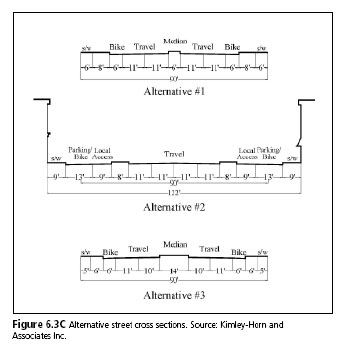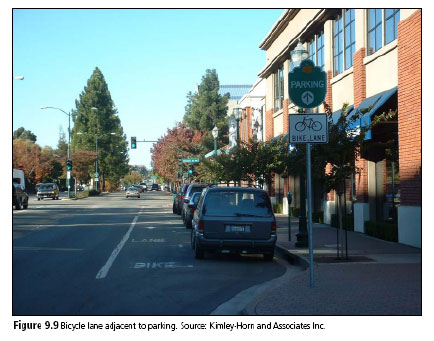I mentioned before that I went on record supporting bicycle lanes and required bike racks at the last public hearing for the proposed Land Development Code for the Heart of Peoria area. I was encouraged to also present my concerns in writing during the public hearing process, so I’ve now done that as well. Here is the text of my letter to the Planning and Zoning commissions:
Please enter this letter into the record at the public hearing on 29 November 2006 identified as “A PUBLIC HEARING TO AMEND THE COMPREHENSIVE PLAN BY INCLUDING AN ILLUSTRATIVE PLAN, REGULATING PLAN, AND CHARRETTE REPORT FOR THE HEART OF PEORIA PLAN AREA.â€
I have two requests for modification to the proposed Land Development Code as outlined below:
1. Include bicycle lanes in examples of street transects.
Section 6.7.1 of the proposed Land Development Code states (emphasis mine), “INTENT: The streets within the Form Districts are intended to balance the needs of all types of traffic—auto, bicycle, and pedestrian—to maximize mobility and convenience for all the citizens and users of the respective districts.†However, in the pages that follow, none of the streetspace examples or specifications show bicycle lanes.
While I recognize that not all urban thoroughfares will include bicycle lanes, such lanes should be incorporated whenever it is feasible to accommodate multimodal travel and ensure the safety of cyclists on busy roadways. Thus, it would be prudent to include in the Land Development Code examples of how bike lanes could be integrated into street design. The following graphics, reprinted from an Institute of Transportation Engineers publication, are provided as examples of what I’m proposing for inclusion:
2. Include bicycle racks in parking requirements for businesses.
Section 6.1.4(F)(8) states that one of the goals of the parking requirements is to “incorporate convenient bicycle parking.” However, sections 6.2 through 6.5 do not specifically require parking facilities for bicycles, such as bike racks. There are many references to “vehicle parking,” but “vehicle” is not defined in section 11, and I would argue that “vehicle” is popularly understood to mean a motorized vehicle, not a bicycle.
Thus, I suggest that in sections 6.2 through 6.5, under each of the Siting requirements, subheading “Garage and Parking,” language be inserted such as “a number of off-street bicycle parking spaces shall be provided equal to the greater of two (2) spaces total or five (5) percent of the automobile parking space requirement.” The numbers and percentages may need to be adjusted; this is just an example of the type of language that would be appropriate to ensure adequate bicycle parking. For an example of bicycle parking requirements in another community, Denver’s regulations can be read on-line at http://massbike.org/bikelaw/~denver.htm.
While I have referenced just the form districts in my letter, I also think it would be a good idea to incorporate these ideas into the entire Heart of Peoria area.
Thank you for your consideration of these requests.
I’d like to say that I discovered these omissions with my own keen observational skills, but that would be untrue. They were actually brought to my attention by Mahkno and Bernie Goitein (independent of each other), so my thanks to them.
Note: The graphics I included are from the Institute of Transportation Engineers publication “Context Sensitive Solutions in Designing Major Urban Thoroughfares for Walkable Communities,” available online here.



In Germany, where there are abundent well planned bicycle routes, the layout differs from what you present.
It is more like:
road-parking-curb(space to open car door)-bicycle route-sidewalk.
Some caveats:
a) the bicycle routes are at the same elevation as the sidewalk.
b) curbs like we have are rarely used. There is a depression for drainage but it resembles a cut for a driveway rather than our domestic curbs. If you look around on the net there are some towns experimenting with ‘curbless’ streets with much success.
c) Bicycles have the right of way over cars. In Germany they have their own stop lights that cycle with the automotive ones. If no lights exist the car must be alert for and yield to bicycle traffic that is on the marked pathway, when turning. Hitting a a law abiding bicyclist will likely cost you your license for life, but that is a whole other issue.
The bicycle path is almost never on the roadway. In contrast London puts its bicycle routes (if you can find any) on the road. The observational difference is that people in Germany abundantly use their bicycles for daily tasks, while Britains rarely use theirs except for pleasure riding (like americans). You can argue that the cultures are different but I would counter that the positioning and availability of routes drives that cultural difference. In a less car friendly time, Britains road bikes regularly too.
Your examples are better than what exists today but it won’t encourage much riding behaviour beyond pleasure and excercise. Riding next to traffic is a dangerous affair. Where would you have your young kids ride? On the sidewalk or that bicycle path? Would you let your kids ride their bikes to school on those routes you illustrate? The answer should be obvious.
I also want to highlight that major roadways akin to Farmington road, War Memorial, Knoxville, Cedar Creek Road, route 8 heading to Edwards, etc. almost always have bicycle routes running parallel to them. Now, those roads will still have the broad greenspace running along them with a drainage ditch like we have. The pathway, which often doubles as a walkway in the country, is set at the far side away from the road. It won’t hug the road like in town. This practice would mitigate the whole rails to trails bs. It isn’t as ‘natural’ but it gets you where you need to go.
For the more natural ride… the germans often drop bicycle routes along the property lines of farms, woodlands. This practice is common throughout Europe incl Britain. Most governments have laws that basically can force it to happen whether a farmer likes it or not. [Pop star Madonna had to fight off such a bicycle path that was proposed running along her estate in the UK. She prevailed in blocking it but only because of privacy concerns over an aggressive paparatzi. But I digress.] The benefit is that a) more pathways become available that have minimal impact on agriculture or industry. b) By making easier for the public to ride and hike in the country, they come to value it more. This makes them less likely to support superfluous development.
C.J.
The city of Rock Island has been experimenting with bike lanes of on some of the streets they have been rebuilding. They really look nice and it is easy to understand the striping after you look at it. Although, I would have to say the first week or so after striping the road people are still getting use to all of the markings and driving in all of the lanes.
-Bill
big waste of money…especially for businesses.
And remember, any nearby train tracks MUST be ripped up….
‘-)
Around here, it would be nice if the cyclists actually obeyed traffic laws. I am talking about the blue jersey wearing Proctor group that runs stop signs, rides in the middle of the roads 2,3,4 abreast or in packs, refuse to move over, yells at drivers, gives drivers rude gestures with their middle finger, and generally acts like a-holes. They apparently don’t need another trail. They won’t use the ones we already have.
Bike racks in those cities that require them or have simply added them are almost always empty or have just 1-2 bikes in them. Kinda reminds me of the over-abundance of handicapped spaces.